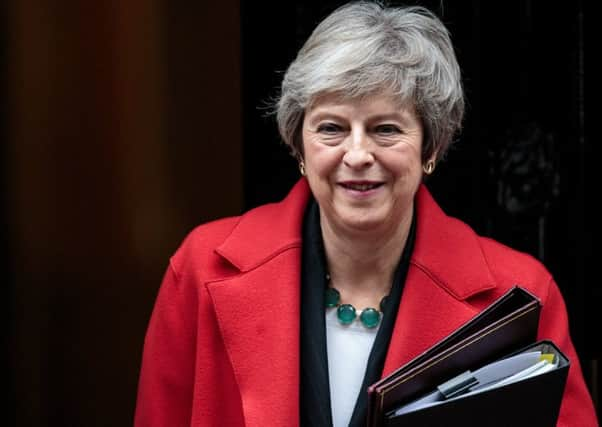Return of ally Rudd as May tries to ride out Brexit coup attempt


Yesterday’s calculated moves followed Michael Gove’s decision to throw the Prime Minister a lifeline by not quitting over the terms of her draft Brexit withdrawal agreement, after 36 hours spent considering his position.
Brexiteers insisted they had the numbers to trigger a vote of no-confidence in Mrs May’s leadership that could come as early as Tuesday, but by last night there was no formal announcement that the threshold of 48 MPs calling for her to stand down had been reached.
Advertisement
Hide AdAdvertisement
Hide AdNew voices of dissent brought the number of publicly confirmed letters to the chairman of the backbench 1922 Committee to 23 yesterday.
Steve Baker, one of the ringleaders, said after speaking to fellow MPs: “My count is a little over 48 with perhaps another dozen probables.”
He later appeared to step back from claiming the threshold had already been reached, saying: “I think we are approaching the moment.”
The weekend is being seen as crucial to the development of the coup, with a failure to collect enough supporters by early next week raising questions over whether Brexiteers can force Mrs May from office.
Conservative whips were told to cancel their plans and return to Westminster to be briefed by the chief whip, signalling a Downing Street charm offensive by telephone while MPs are in their constituencies over the weekend to stave off the possibility of a confidence vote.
At the end of one of the most challenging weeks of her premiership, Mrs May was spared a final, probably fatal blow by the Environment Secretary’s decision to stay on in government despite deep reservations over the draft withdrawal deal.
Asked if he had confidence in the Prime Minister, Mr Gove said: “I absolutely do.”
He added: “I am looking forward to continuing to work with all colleagues in government and in Parliament to get the best future for Britain.”
Advertisement
Hide AdAdvertisement
Hide AdA Downing Street spokeswoman said Mrs May was “very pleased” Mr Gove would stay on and “continue doing the important work he is doing”.
There was also support from Brexiteer Trade Secretary Liam Fox, who said he had “full confidence in the Prime Minister” and added: “What we need now is stability.”
And in a marked departure from Mrs May’s “no deal is better than a bad deal” mantra, he told an event in Bristol: “Ultimately I hope that across Parliament we’ll recognise that a deal is better than no deal.”
However, there were signs that the Brexiteers remaining in Cabinet could continue to work against the Prime Minister behind the scenes. There were reports Mr Gove and Mr Fox would meet with International Development Secretary Penny Mordaunt and Leader of the Commons Andrea Leadsom to discuss how to push for concessions on the issue of the Irish border backstop.
Mrs May sought to shore up her position by bringing one of her closest allies back into government, appointing Amber Rudd as Work and Pensions Secretary.
The Prime Minister has also taken personal control of Brexit negotiations with Brussels, appointing a junior figure as Brexit Secretary to oversee domestic preparations for leaving the EU.
Stephen Barclay, a former whip and junior minister at the Treasury and Department of Health, takes over from Dominic Raab, who sparked chaos by resigning on Thursday over the draft Brexit withdrawal agreement.
There is just over a week left until a planned special EU summit to sign off the UK’s “divorce deal”, and finalise a political declaration setting the direction of travel for future trade talks.
Advertisement
Hide AdAdvertisement
Hide AdDowning Street said this would be handled by the Prime Minister and UK officials in Brussels.
In a statement, Downing Street declined to say whether the Brexit Secretary post had been offered to anyone else before the North-East Cambridgeshire MP, following reports Mr Gove and the Attorney General Geoffrey Cox had both turned it down, saying only: “He was the Prime Minister’s choice for the job.”
Ms Rudd, who stood in for the Prime Minister in televised debates during the 2017 election campaign, resigned as Home Secretary in April over the Windrush scandal.
Asked what Mrs May would say to victims of the Windrush scandal who might feel the Hastings & Rye MP’s rehabilitation had come too soon, the PM’s official spokesman said: “The government has apologised, the Prime Minister and Home Secretary apologised for the Windrush scandal … work is ongoing to make sure those people are properly compensated.”
Yesterday the Prime Minister had a taste of some of the bewilderment at the deal while taking questions on a morning radio phone-in programme, with one caller telling her she had “appeased” the EU like Neville Chamberlain in his negotiations with Hitler.
Another claimed Jacob Rees-Mogg would make a better leader.
